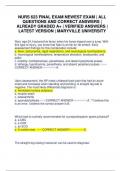NURS 623 FINAL EXAM NEWEST EXAM | ALL
QUESTIONS AND CORRECT ANSWERS |
ALREADY GRADED A+ | VERIFIED ANSWERS |
LATEST VERSION | MARYVILLE UNIVERSITY
Stan, age 34, fractured his femur when his horse tripped over a jump. With
this type of injury, you know that Stan is at risk for fat emboli. Early
assessment findings for this complication include:
a. fever, tachycardia, rapid respirations, and neurological manifestations.
b. neurological manifestations, temperature elevation, bradycardia, and
pallor
c. hostility; combativeness, paresthesia, and absent peripheral pulses.
d. lethargy, hypothermia, paresthesia, and absent peripheral pulses. ------
CORRECT ANSWER---------------A.
Upon assessment, the NP notes unilateral back pain that had an acute
onset and increases when standing and bending. A straight leg test is
negative. The most likely differential diagnosis is:
a. herniated nucleus pulposus.
b. muscle strain
c. osteoarthritis
d. spondylolisthesis ------CORRECT ANSWER---------------A. **I believe this
is an error. I believe the correct answer is B.
Which test is routinely recommended for a preparticipation sports physical?
a. a CBC
b. a CXR
c. an ECG
d. A snellen test. ------CORRECT ANSWER---------------D.
The straight-leg-raising maneuver can be used to diagnose:
,a. nerve root compression
b. a fractured hip
c. an anterior cruciate ligament tear
d. tendinitis. ------CORRECT ANSWER---------------A.
A 55 year old patient presents with complaints of paresthesias into the
lateral lower arm, thumb, and middle finger. The most commonly involved
nerve roots that cause the related symptoms are c6-c7. The most likely
differential diagnosis would be:
a. brachial plexus neuritis
b. cervical radiculopathy
c. peripheral polyneuropathy
d. thoracic outlet syndrome ------CORRECT ANSWER---------------B.
Which of the following can assist in the diagnosis of myasthenia gravis?
a. repetitive nerve stimulation
b. the presence of cogwheel rigidity
c. Chvostek's sign
d. Trousseau's sign ------CORRECT ANSWER---------------A.
Jennifer says that she has heard that caffeine can cause osteoporosis and
asks you why? How do you respond?
a. caffeine has no effect on osteoporosis
b. a high caffeine intake has a diuretic effect that may cause calcium to be
excreted more rapidly.
c. caffeine affects bone metabolism by altering intestinal absorption of
calcium and assimilation of calcium into the bone matrix.
d. caffeine increases bone resorption. ------CORRECT ANSWER--------------
-B.
The NP has just completed a work-up on Michael, age 13, and confirmed
Osgood-Schlatter disease. The initial management would be to:
,a. refer to orthopedics for early surgical correction.
b. recommend physical therapy for quadricep strengthening exercises
c. advise him to temporarily discontinue all sports activities until his growth
plates have completely fused.
d. tell Michael that he can resume his usual activities immediately without
concern and should begin aggressive exercises to increase muscle bulk
and strength. ------CORRECT ANSWER---------------B.
For an adult patient with a knee injury, the NP orders an NSAID to be taken
on a routine basis for the next two weeks. Patient teaching should include
which of the following:
a. you may take the medication on an empty stomach as long as you eat
within 2 to 3 hours of taking it
b. If one pill does not seem to help, you can double the dose for
subsequent doses.
c. If you notice nausea/vomiting or black or bloody stools, take the next
dose with a glass of milk or a full meal.
d. if you have additional pain, an occasional acetaminophen is permitted in
between the usual doses of the NSAID. ------CORRECT ANSWER------------
---D.
You are assessing Jamal, age 16, after a football injury to his right knee.
You elicit a positive anterior/posterior drawer sign. This test indicates an
injury to the:
a. lateral meniscus
b. cruciate ligament
c. medial meniscus
d. collateral ligament. ------CORRECT ANSWER---------------B.
Carol, age 62, has swollen, bony proximal interphalangeal joints. The NP
describes these as:
a. heberden's nodes
b. bouchard's nodes
c. osler's nodes
, d. murphy's nodes ------CORRECT ANSWER---------------B.
Sean, a factory line worker, has osteoarthritis of the right hand. According
to the American college of rheumatology (ACR), the guidelines for
pharmacological treatment include:
a. acetaminophen, tramadol, and intra-articular corticosteroid injections
b. oral NSAIDS, Tramadol, and articular corticosteroid injections
c. acetaminophen, topical capsaicin, and topical NSAIDS
d. topical capsaicin, topical NSAIDS, and oral NSAIDS. ------CORRECT
ANSWER---------------B. **This answer is not correct.
Guidelines recommend:
"We conditionally recommend that health professionals
should use one or more of the following:
Topical capsaicin
Topical NSAIDs, including trolamine salicylate
Oral NSAIDS"
When grading muscle strength on a scale of 1 to 5, a grade of 4 indicates:
a. Full range of motion against gravity with full resistance.
b. full ROM against gravity with some resistance.
c. full ROM with gravity.
d. full ROM with gravity eliminated (passive motion) ------CORRECT
ANSWER---------------B.
Margaret, age 55, presents to you for evaluation of left hand and wrist pain
and swelling after a slip and fall on the ice yesterday. On examination, you
note tenderness at her "anatomical snuffbox" You know this probably
indicates:
a. ulnar styloid fracture
b. scaphoid fracture
c. hamate fracture
d. radial head fracture. ------CORRECT ANSWER---------------B.




